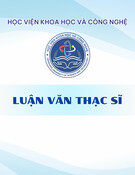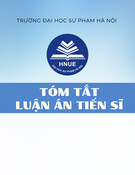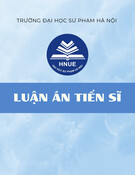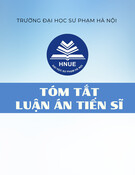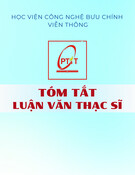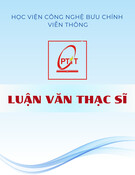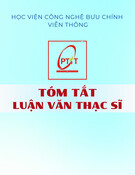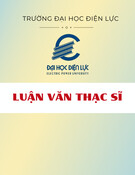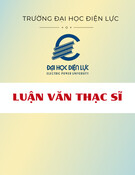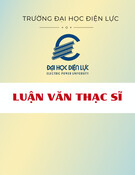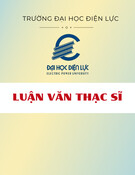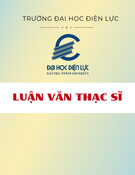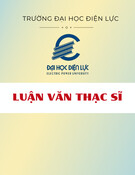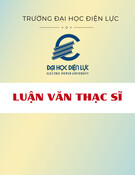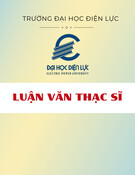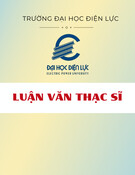
MINISTRY OF EDUCATION MINISTRY OF AGRICULTURE
AND TRAINING AND RURAL DEVELOPMENT
VIETNAM ACADEMY OF AGRICULTURAL SCIENCES
NGUYEN THI BICH THUY
STUDY ON BIOLOGICAL CHARACTERISTICS AND
TECHNOLOGY OF SPAWN PRODUCTION,
CULTIVATION OF KING OYSTER MUSHROOM
(PLEUROTUS ERYNGII) AND YUNZHI MUSHROOM
(TRAMETES VERSICOLOR) IN VIETNAM
Branch of study: Crop Science
Code : 62.62.01.10
SUMMARY OF DOCTORAL THESIS
Hanoi - 2014

This thesis is completed at:
VIETNAM ACADEMY OF AGRICULTURAL SCIENCES
Science supervisor:
1. Prof. Ph.D. Trinh Tam Kiet
2. Ass. Dr. Nguyen Trung Thanh
Critic 1: ............................................................................
Critic 2: ............................................................................
Critic 3: ............................................................................
The thesis will be defended before Council for thesis assessment at
Institutional level held at Vietnam Academy of Agricultural Sciences
at ...... hour ..... minute, day .... month ..... year .....
This Thesis can be referred to at:
1. National Library
2. Library of VietnamAcademy of Agricultural Sciences
3. Library of......................................................................

1
INTRODUCTION
1. The urgency of the topic
King Oyster Mushroom (Pleurotus eryngii (DC.) Quél) is a delicious,
edible fungus, high nutritional and medicinal values. King oyster
mushroom’s fruiting bodies are of large size, pretty shape, so for these
advantages, this fungus is called "King Oyster mushroom”. Yunzhi
mushroom (Trametes versicolor (L.) Pilat) is a medicinal fungus of very
high medicinal value, that has been preferred by consumers in countries
like China, Japan, European, American countries,... In Yunzhi mushroom,
there are polysaccharide compounds associated with protein, consisting of
two main types: PSP (polysaccharide peptide) and PSK (polysaccharide
krestin). PSP and PSK have the effect to inhibit various types of cancer
cells such as carcinoma cell (carcinoma), cancer of the blood cells
(leukemia), stomach cancer, colon cancer, throat cancer, lung cancer and
breast cancer …... (P.M.Kidd, 2000).
Together with the development of society, the demand for people’s
is not only good, but also nutritious, safe and valuable health promoting
food. Now, on the market, there are many types of edible and medicinal
mushrooms imported from China into Vietnam with quantity of hundreds
of tonnes/year, by many different ways, without origins, long time of
transportation, using preservatives, thus causing bad psychological
attitudes for consumers. Currently, the edible mushroom - medicinal
mushrooms cultivated in Vietnam, especially the King Oyster and Yunzhi
mushrooms are still interested by consumers.
The production of edible - medicinal mushrooms is growing strongly,
the units of breeding and cultivating mushrooms in our country are all
applying traditional breeding technologies (solid), so there exist some
disadvantages as: high rate of disease - infected spawns, long incubation
time for one spawn level with an average duration from 10-25 days, the
time from implanting spawns into farming materials to commercial
mushroom picking is long, within 2 months that lead to high prices for
spawn and commercial mushrooms . While research and seed production
of liquid spawn in world has reached some remarkable achievements. The
application of liquid spawn production show remarkable effectiveness as
compared to solid spawn production, that help shortening growth duration
of one spawn level down to only 3-5 days, with high purity, good quality,
reducing infection rates, appropriate for spawn production and mushroom
cultivation in industrial scale.

2
In order to contribute to the overcoming of the above limitations, edible -
medicinal mushrooms in general and King Oyster -Yunzhi mushrooms in
particular to develop effectively, the research theme: "Study on biological
characteristics and technology of spawn production, cultivation of the King
Oyster Mushroom (Pleurotus eryngii) and Yunzhi mushroom (Trametes
versicolor) in Vietnam" has been conducted.
2. Objective of topic
To conduct research on some biological characters of strains of
King Oyster and Yunzhi mushrooms to identify best developing strains in
climatic condition of Vietnam, and at the same time, to set up spawn
production technologies for mushroom strains of liquid spawn in order to
improve production efficiency for edible and medicinal mushrooms.
3. Scientific and practical significances
3.1. Scientific significance
The findings of the study have provided scientific data on the basic
growth indicators of King Oyster mushroom (P. eryngii) and Yunzhi
mushroom (T. versicolor), as well as the need for nutrition and optimal
environmental conditions for growth and development of two mushroom
varieties on liquid cultivation; pointing out the genetic differences of the
currently being stored strains and correlation with the biological
characteristics in the cultivation, and at the same time, to provide the data
observed by the electron microscope.
3.2. Practical significance
Through the results of the research subject, two mushroom varieties
of King Oyster mushroom (P. eryngii) and Yunzhi mushroom
(T.versicolor), suitable for growing conditions in Vietnam, have been
released to production; at the same time, propagation technologies in
liquid types for these two strains have been set up, improving their growth
capacity, shorterning incubation time, increasing productivity of
commercial mushrooms. This technology is highly feasible, capable of
applicating in mushroom production in industrial scale.
3.3. The novelty of the thesis
Having studied the morphological characteristics basidiospores,
indicating the growth characteristics and development of mushroom
mycelium and fruiting bodies; simultaneously assess the genetic
differences between strains of King oyster mushroom and Yunzhi

3
mushroom. On that basis, edible mushrooms and medicinal mushrooms
adaptable to production conditions of Vietnam have been selected.
Having build up successful propagation processes for liquid spawns
of King oyster and Yunzhi mushrooms (from propagation of the first grade
spawn → intermediate spawn → commercial spawn and using for
cultivation); replacing traditional technologies, shortening incubation time,
increasing mushroom yield, enhancing economic efficiency.
4. The layout of the thesis
The main content of the thesis are presented in 134 pages (excluding
references and appendices). Introduction: 4 pages; Chapter 1: Overview
document: 36 pages; Chapter 2: Materials, content and research
methodology: 17 pages; Chapter 3: Research Results and Discussion: 75
pages; Conclusions and recommendations: 2 pages. The thesis consists of
26 tables, 65 figures, 18 Vietnamese documents, 78 documents in English.
The appendix includes: Process Mapping; Calculation of the economic
efficiency of liquid spawn multiplication technologies in comparison with
traditional technologies; Images of mushroom spawns and mushroom
fruiting bodies in some experiments; Results of statistical analysis and
experimental data processing and content related to the thesis.
Chapter 1
OVERVIEW
1.1 . Status of research and production of mushrooms in the world and
in Vietnam
1.1.1. Status of research and production of mushrooms in the world
1.1.1.1 . Research situation on multiplication of liquid spawns and
cultivation of King Oyster and Yunzhi mushrooms
As King oyster and Yunzhi mushrooms are of high medicinal value,
they are interested to be studied
on by many concerned countries. Scientists around the world have
conducted further studies in the growth capacity of King oyster and Yunzhi
mushroom by the effects of additional nutrient supply such as sources of
carbon, nitrogen, mineral as well as their best additional contents.
Authors also studied the effect of pH, temperature, nutrients to the
growth of King oyster and Yunzhi musrooms. Cultivating materials and
nutritional supplement components, nutrient contents were also mentioned.
Deep layer nurturing fermentation method (liquid spawn
multiplication/propagation) is applied to produce different varieties of

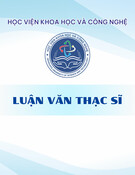

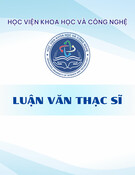
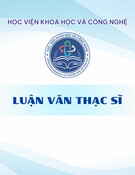
![Luận văn Thạc sĩ: Tổng hợp và đánh giá hoạt tính chống ung thư của hợp phần lai tetrahydro-beta-carboline và imidazo[1,5-a]pyridine](https://cdn.tailieu.vn/images/document/thumbnail/2025/20250816/vijiraiya/135x160/26811755333398.jpg)

